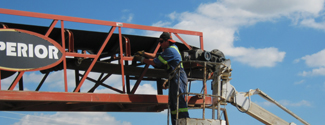Proper maintenance of conveyors and stackers is important to keep equipment operating efficiently in order to maximize production, minimize downtime and maintain the lowest overall operating costs.

In order to properly maintain equipment you should have a regular planned maintenance schedule that includes keeping in depth maintenance records. Maintenance should include daily inspections of the belt and components, lubrication and adjustments as required, cleaning material build up from machine and checks to ensure that idlers and return rollers contact the belt and run free under load.
Failure to perform the manufacturer’s regular maintenance and service can result in premature or excessive wear to parts and components and may shorten the overall life of equipment. Don’t let conveyor maintenance be the weakest link in your operation.
Safety First
Before beginning any sort of maintenance or service on conveyors, it’s important that the equipment is shut down, empty and locked out. Not only is this a critical step to ensure safety, but also ensures that the entire unit is free of material and can be inspected and repaired as required.
Inspect the entire conveyor for wear and tear
The first step is to inspect the belt and splice for damage. Visually inspect for wear as well as any tears or adhesions to the belt carcass that may need to be repaired. Damages can be repaired using hot vulcanized or mechanical methods. It’s critical to make the repairs in a timely fashion in order to prevent further deterioration to the belt or risk contamination of processed material from the breakdown of the belt carcass.
Check the tail pulley for built up and trapped material. Ensure the head pulley is clean; inspect the lagging and replace if the rubber is worn, smooth or hard. Check the pulleys or idlers for build up and inspect all scrapers, plows and self trainers to ensure that they are operational. Also inspect the primary and secondary loading locations for damage to skirting, impact bed/idlers. Any problems with these components could result in belt damage or create belt tracking problems.
After all of the inspections and maintenance have been completed, it’s a good practice to walk the entire conveyor while it runs with the belt empty to check for any belt tracking problems. Before making any tracking adjustments though, it’s a good idea to run the belt again while loaded since an empty belt doesn’t always perform the same once loaded.
While the conveyor is running with a load check once again to ensure that pulleys and idlers are turning freely without any bearing noise and the belt is tracking properly. Check for material build up on the return side of the belt and ensure that there’s no slippage on the head pulley when starting or running, and once again, ensure that the scrapers and plows are functioning properly.
Once the conveyor frame, components and belt have been serviced, properly lubricated and adjusted, your conveyor is set to give you a long life of reliable service and dependability that you can count on.
Download our Belt Training Guide to assist you with any belt training procedures.


